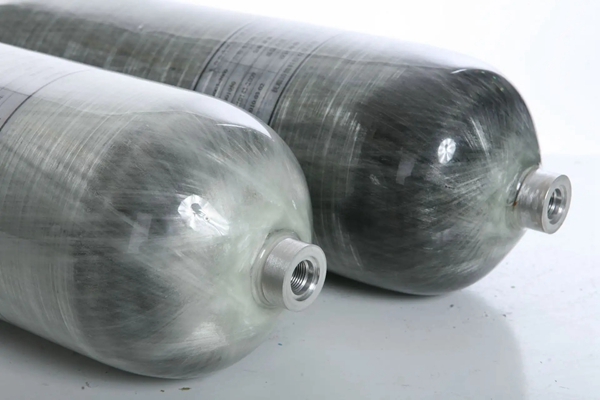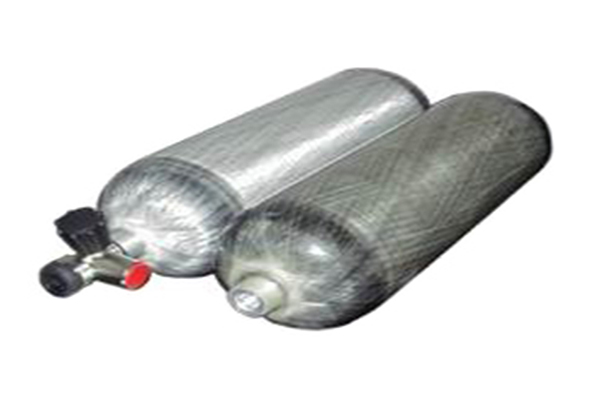Fiber Wound Composite Gas Cylinders Manufacturing Technology
09 September 2023


Fiber wound composite gas cylinders are generally composed of inner lining, fibers, resins, etc. The inner wall of the composite gas cylinder inner lining is directly in contact with the medium, and its main functions are airtightness, anti-corrosion, temperature resistance, and pressure resistance; Therefore, it is required that the lining material have good airtightness, corrosion resistance, temperature resistance, high strength, and high toughness There are two commonly used lining materials: aluminum and plastic The main function of fiber winding reinforced composite material layer is to ensure that the gas cylinder has sufficient strength, stiffness, and stability under stress The composite material winding layer bears the vast majority (75%~95%) of the pressure load, with fibers as the main load-bearing body, and resin plays a bonding role on the fibers, distributing and transmitting loads between them; Therefore, selecting high-strength and highly elastic reinforcing fibers and high-performance resins is an important measure to improve the load-bearing capacity of structures High performance composites such as high-strength glass fiber epoxy resin or carbon fiber epoxy resin and Kevlar fiber epoxy resin are usually used.
Composite material gas cylinders are generally classified into two methods: firstly, according to the application field, they are divided into: 1. Fuel gas cylinders for natural gas, hydrogen, and other fuel vehicles; 2. Used for respirator systems, including backpack mounted respirators, small respirators, and breathing masks for escape; 3. Used for aviation or navigation, mainly including escape slide inflation devices and aviation oxygen absorption devices; 4. Liquefied gas cylinders for household use, etc
Composite material gas cylinders are generally classified into two methods: firstly, according to the application field, they are divided into: 1. Fuel gas cylinders for natural gas, hydrogen, and other fuel vehicles; 2. Used for respirator systems, including backpack mounted respirators, small respirators, and breathing masks for escape; 3. Used for aviation or navigation, mainly including escape slide inflation devices and aviation oxygen absorption devices; 4. Liquefied gas cylinders for household use, etc
Composite material gas cylinders are generally classified into two methods: firstly, according to the application field, they are divided into: 1. Fuel gas cylinders for natural gas, hydrogen, and other fuel vehicles; 2. Used for respirator systems, including backpack mounted respirators, small respirators, and breathing masks for escape; 3. Used for aviation or navigation, mainly including escape slide inflation devices and aviation oxygen absorption devices; 4. Liquefied gas cylinders for household use, etc
Fiber wound composite gas cylinders have the following advantages: 1. Light weight, good rigidity, and high strength; 2. The fatigue failure of metal materials is usually a sudden failure without obvious omen, and the combination of reinforcement and matrix in composite materials can not only effectively transfer the load, but also prevent the crack growth, which improves the fracture toughness of gas cylinders; 3. When a large number of reinforced fibers in composite materials cause material overload and a few fibers break, the load will be quickly redistributed to the undamaged fibers, so that the entire gas cylinder will not lose its load-bearing capacity in a short period of time; 4. Composite gas cylinders will not produce dangerous fragments when damaged by impact or high-speed impact, thereby reducing or avoiding injury to personnel; 5. It can meet the requirements of corrosion resistance without special treatment.
Manufacturing of composite gas cylinders:
The main function of the fiber reinforced layer of composite gas cylinders is to withstand pressure, so the fiber layer has a significant impact on the mechanical properties of composite materials when manufacturing composite gas cylinders, the main factors considered for the fiber reinforced layer include the winding tension of the gas cylinder, the laying sequence, the winding angle, the winding thickness, and the wire type of the fiber winding.
During the winding manufacturing process of composite gas cylinders, a certain amount of tension needs to be applied to the fibers. On the one hand, it is to arrange the fibers according to the design line on the inner liner, and on the other hand, it is to generate a certain degree of prestress on the inner liner and winding layer of the gas cylinder, thereby improving the fatigue resistance of the gas cylinder,Research and development personnel Chen Ruxun proposed that the important reason for affecting the strength of fibers is the uneven force distribution of fibers along the thickness direction of the gas cylinder, and the winding tension is an important factor for the uneven force distribution of fibers, especially for gas cylinders with thicker walls; Therefore, how to reasonably control the winding tension is an important link in improving the strength of gas cylinder fibers Engineer Zhang Zongyi et al. proposed an equivalent cooling method, which equates the pre-stress generated by winding tension to the pre-stress generated by composite material layer cooling. The effect of winding tension on the stress of circumferential winding composite material gas cylinders was studied using finite element software The research results indicate that as the winding prestress increases, the working stress of the inner liner of the circumferential winding composite material gas cylinder decreases, and the working stress of the composite layer increases. When the prestress generated by the winding tension is large, it will counteract the effect of the self tightening process,Wang Xinrong, an engineer, studied the influence of winding tension on the bursting pressure of carbon fiber wound aluminum liner composite cylinder. The simulation results showed that the bursting pressure of the cylinder with winding tension was 3.03% higher than that of the cylinder without winding tension. Cohen used experimental design methods to determine the influence of fiber prestress on the structural mechanics performance of winding during the winding process, It was found that increasing prestress can effectively increase the volume percentage of fibers in the winding layer of the fiber winding structure, thereby improving the strength of the structure.
Kalaycioglu et al. studied the Kevlar fiber wound 6061-T6 aluminum lined composite gas cylinder, mainly focusing on the influence of symmetrical and asymmetrical laying sequence on the cylinder performance when the winding angle of the fiber changes continuously. The research results show that the symmetrical laying sequence increases the bursting pressure by 15% compared with the asymmetrical laying sequence, mainly because the symmetrical laying sequence makes the stress distribution of the cylinder fiber layer more uniform, Reduced stress concentration Bertin et al. conducted experimental and simulation studies on polymer composite hydrogen storage cylinders, mainly focusing on the influence of the stacking sequence of the composite layer on the mechanical properties of the composite material. The research results showed that the symmetrical stacking sequence had the highest failure stress value Velosa et al. studied composite gas cylinders wrapped with polyethylene lined glass fibers and found that the direction of the fibers, the order of layers, and the number of layers can all affect the strength of the fiber winding layer.
Carbon fiber composite high-pressure gas cylinders and manufacturing
A carbon fiber composite material high-pressure gas cylinder, which includes a metal lining and carbon fiber composite material layer wrapped on the surface of the metal lining. The ends are welded on the heads at both ends of the central axis of the metal lining, and there are circumferential ribs wrapped on the outside of the carbon fiber composite material layer. The characteristic is that the metal lining is made of titanium alloy with a tensile yield strength to elastic modulus ratio of at least 0.6% FTY/E and a fracture elongation of at least 5%, The thickness of the finished metal lining ranges from 0.5mm to 1.8mm, and the ratio of thickness to diameter of the metal lining is 2.8 × Below 10 to 3, the ratio of length to diameter of the cylindrical part of the metal lining is at least 1.00. The head of the metal lining is in the shape of a three point circular head, and the metal lining is prepared through five steps: spinning, stretching the head, recrystallization annealing treatment, mechanical processing, end welding, and welding the entire body; The carbon fiber composite material layer is a carbon fiber/epoxy winding layer, which means that the epoxy resin is mixed with an anhydride curing agent and benzyl dimethylamine accelerator in a weight ratio of 1:0.08-0.1:0.005-0.006 to form a gel, and then the impregnated carbon fiber is wound on the outer surface of the metal lining to prepare it.
Wild et al. found through grid analysis that the optimal angle for filament wound composite pressure vessels is 54.74 °. Parnas et al. considered the effect of internal pressure on filament wound composite gas cylinders and concluded that the optimal winding angle mainly depends on geometric shape and failure criteria used, And the range of winding angle is given to be 52.1~54.2 °. Rosenow analyzed the stress and strain situation of thin-walled composite containers when the winding angle changes between 15 °~85 ° using classical lamination theory; For cylindrical vessels with a ratio of circumferential stress to axial stress equal to 2, the optimal equilibrium winding angle is 55 ° Erkal et al. conducted experimental research on the fatigue failure of composite pressure vessels with glass fiber wrapped plastic liners. The glass fibers were wrapped in a symmetrical manner, with winding angles of ± 75 °, ± 60 °, ± 55 °, and ± 45 °. The experimental results showed that when the winding angle was ± 55 °, the maximum burst pressure was 10.2 MPa
The thickness of fiber winding is not necessarily the better. If the fiber winding is too thick, not only will it increase manufacturing costs, but also the strength of the outer layer fibers cannot be fully utilized, resulting in material waste Researcher Gu Haibo designed the circumferential winding thickness of a 2 L carbon fiber wound aluminum liner composite gas cylinder As the thickness of the circumferential fibers increases, the stress levels of the inner liner and fibers decrease under working pressure and minimum burst pressure, while the stress ratio of the fibers decreases According to the DOT-CFFC standard, the range of values for fiber monolayer thickness is 0.13 ≤ t ≤ 0.14 mm
For fiber winding structures, the linetype of fiber winding is an important design parameter At present, there are three basic types of fiber winding: circumferential winding, longitudinal winding, and spiral winding Circumferential winding is carried out along the circumference of the container and can only be carried out on the cylinder section. The angle of fiber winding is usually between 85 ° and 90 °, and the winding process is simple The fiber trajectory of longitudinal winding is a single circular plane closed curve with a small winding angle, and is mostly used for thick and short containers Spiral winding is also known as geodesic winding. When winding, the wire guide rotates at a constant speed along the mandrel axis at a specific speed. The barrel section and head can be filament wound at a winding angle of about 12 °~70 °. The winding process is complex, Engineers such as Chi Xiufen found through collision damage research that the ability of spiral winding to resist damage is higher than that of ordinary circumferential winding. Therefore, it is recommended to use spiral winding when manufacturing composite pressure vessels In the manufacturing of composite gas cylinders, a spiral and circumferential winding shape is generally used.



